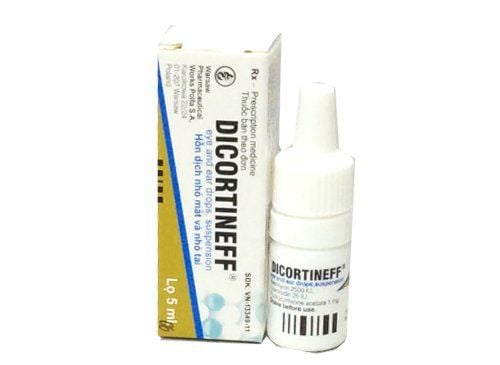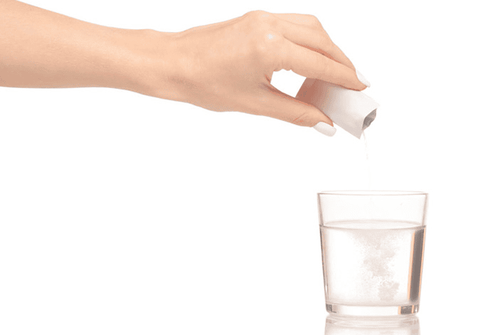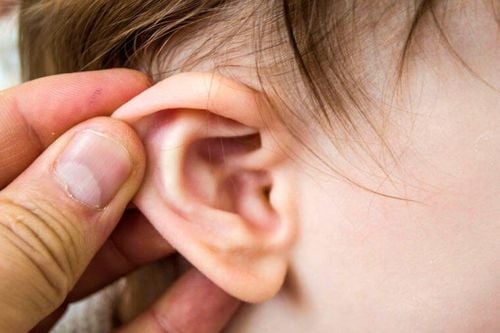This is an automatically translated article.
The article was professionally approved by Master, Doctor Dang Huy Toan - Department of Pediatrics - Neonatology - Vinmec Nha Trang International General Hospital.Otitis media is an infection and damage that occurs in the middle ear due to bacteria that multiply and grow in the ear or are affected by external factors in the environment. Otitis media causes symptoms of pain, discomfort, fever, refusal to breastfeed, picky eating, ... and is often treated with antibiotics. However, some other opinions regarding antibiotic treatment of otitis media or delay are of interest.
1. Research on antibiotic use or delay in the treatment of middle ear infections
Two new studies published in the June issue of the journal Pediatrics offer the following notable information:The first study, a clinical trial, showed immediate antibiotic treatment help minimize the symptoms of middle ear infection for the first 10 days. But just watching and waiting to see if the infection gets worse – cuts antibiotic use by two-thirds. Thirty days after the first doctor visit, cure rates were the same in the immediate treatment group and the wait-and-see group.
The second study surveyed parents and doctors in six communities in Massachusetts. About a third of parents said they would be satisfied with their child's otitis media treatment if the doctor advised them to watch and wait. But 40% think this will not be possible. Meanwhile, 38% of doctors said they never used the watch-and-wait approach when they had otitis media. Only 6% said they monitor and delay taking their medication most of the time, while 39% said they don't often delay taking their medication.
2. Can otitis media go away on its own?
Most of the time, otitis media resolves on its own, but must be carefully monitored. That's because otitis media is caused by a buildup of fluid in a child's middle ear, creating favorable conditions for pathogens — like bacteria — to grow in a vital area of the body.The most common treatment for otitis media in the United States is giving children antibiotics right away. This method almost always works, as the child's ears are cleaned. But the disease also goes away on its own if left untreated. In fact, two-thirds of children, according to a study in the journal Pediatrics, improve without antibiotics.
Doctors and parents often worry that a serious infection can start from a simple earache, which is why so many of them want early treatment. However, there is a downside. Sixty percent of antibiotic prescriptions for children are for otitis media. Such massive use of antibiotics is leading to a bacterial counterattack. Bad bacteria are becoming resistant to antibiotics. This means that in the future, effective treatment will be more difficult and expensive.
Can doctors really cut down on antibiotics for otitis media? The American Academy of Pediatrics and the American Academy of Family Physicians have taken the first step. Last year, they released treatment guidelines that give doctors the option to watch and wait for non-severe cases of otitis media - only mild ear pain and no high fever - for children 2 years of age and older. .
But the question remains, is watching and waiting really work? And even if this does work, would parents and doctors really accept the plan of watching and waiting to see if the ear infection goes away on its own?

Phương pháp điều trị viêm tai giữa bằng kháng sinh cần được cân nhắc
3. Antibiotics right away and always, or wait and see
Dr. David McCormick, of the Department of Medicine - University of Texas, Galveston, led a study of 223 children aged 6 months to 12 years with non-serious otitis media. These children have symptoms of otitis media, there is fluid in the ear, but the infection is not severe. Half of the children were treated with 2 doses of the antibiotic amoxicillin per day for 10 days. The other half were sent home, where the parents were asked to continue to monitor the children's recovery. If not, parents will take the children to see a doctor for antibiotics.During the first 12 days, children in the treatment group tended to get over their symptoms more quickly, and needed less pain relief. However, these children are also at higher risk of encountering drug-resistant bacteria. And early treatment does not prevent them from having a relapse within 30 days.
By day 30, the cure rate in both groups was nearly the same: 77% in the immediate treatment group and 76% in the wait-and-see group. The level of parental satisfaction in the 2 groups was similar with each type of treatment at both 12 and 30 days.
It is important to note here that 66% of young children in the watch and wait group did not need antibiotic treatment. Researchers have identified key factors that make watch and wait effective:
Doctors must assess the severity of otitis media. Physicians must educate parents about the risks of untreated otitis media and the risks of overprescribing antibiotics. Symptoms of otitis media need to be controlled. Children have conditions to continue to be examined and followed up. Where necessary, effective antibiotics should be available.
4. Under what circumstances should the wait-and-see approach be used?
Harvard researcher-Dr., Master of Public Health Jonathan Finkelstein, et al. points out that some experts don't think this is a good idea, despite new treatment guidelines.To see if watch and wait really works for otitis media, Finkelstein's team asked more than 2,000 parents and 160 doctors what they thought about stopping antibiotic treatment, and they found:
38% of parents said they would be satisfied or extremely satisfied with follow-up and wait. 40% of parents said they would be dissatisfied or extremely dissatisfied with follow-up and wait. 38% of doctors say they never or almost never try watch and wait. 39% of doctors say they "occasionally" try to watch and wait. 17% of doctors say they "sometimes" try to watch and wait. 6% of doctors say they almost always advise parents to watch and wait.

Trẻ cần được thăm khám bởi các bác sĩ chuyên khoa giàu kinh nghiệm
But for doctors, it's not so obvious. Although there are benefits to the community such as reducing antibiotic resistance, the watch-and-wait approach does not bring too great benefits for individual patients. Some experts don't think it's a good idea. And US doctors tend to prefer active treatment to passive waiting. For all of these reasons, one might predict that the practice of [watch-and-wait for the treatment of non-acute otitis media] will be approved slowly, the researchers suggest: widely,” suggested the researchers.
Vinmec International General Hospital examines and treats common ear, nose and throat diseases, head and neck tumors, congenital malformations of the ear, nose and throat area with the most optimal internal and surgical methods for patients, both children and adults. Coming to Vinmec International General Hospital, patients will receive a direct, dedicated and professional examination from a team of qualified and experienced medical staff.
Please dial HOTLINE for more information or register for an appointment HERE. Download MyVinmec app to make appointments faster and to manage your bookings easily.
Reference source: webmd.com












